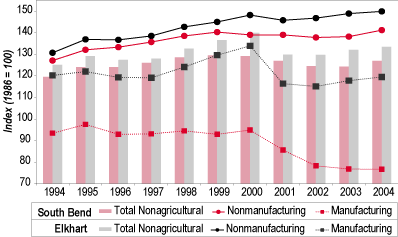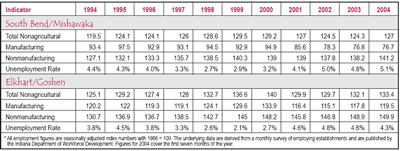South Bend/Mishawaka and Elkhart/Goshen
Indiana University South Bend
Indiana University South Bend
To help understand how we came to where we are today, Table 1 and Figure 1 provide data from 1994 to the middle of 2004 that chart the longer-term progress of the Michiana region, of which South Bend/Mishawaka and Elkhart/Goshen are a major part. The index uses 1986 as the base period and employs monthly averages of seasonally adjusted index numbers.
Table 1
Employment Index with Unemployment Rates, 1993 to 2004*
Figure 1
Employment Index for South Bend/Mishawaka and Elkhart/Goshen

Employment growth in the South Bend economy mirrored the sluggish growth experienced by the national and state economies. During 2003, South Bend’s total nonagricultural employment decreased by 0.2 percent, with manufacturing employment contracting by 1.9 percent and nonmanufacturing employment increasing by a modest 0.1 percent.
Employment growth in Elkhart, for the second year in a row, outpaced South Bend, the nation, and the state. Elkhart’s total nonagricultural employment grew by 1.9 percent, with manufacturing expanding by 2.4 percent and nonmanufacturing advancing by 1.5 percent.
The contraction of manufacturing employment in South Bend and its expansion in Elkhart derived largely from each economy’s differing fortunes in the transportation equipment sector (as defined by the Standard Industrial Classification—SIC 37). In South Bend, transportation equipment remained strong throughout 2002, ending the period with an 11 percent increase (500 more jobs). This upswing likely resulted from the strong sales following the initial launch of the Hummer H2 sport utility vehicle. But in 2003, Hummer H2 sales weakened because of the natural moderation in sales that follows the successful introduction of a new vehicle. Consequently, SIC 37 employment failed to grow.
Further, manufacturing employment in South Bend’s other durable and nondurable manufacturing continued the downward trend of 2002 into 2003, contributing to the overall weakness in manufacturing. In Elkhart, SIC 37, primarily fueled by the robustness of the booming recreational vehicle market, increased by 5,200 jobs from December 2001 to December 2002, a 24.8 percent boost, and added another 1,600 jobs between December 2002 and December 2003, a 6.5 percent change. During 2003, nonmanufacturing employment advanced in South Bend by 0.1 percent. Employment expanded in retail trade (1.7 percent), leisure and hospitality (5.8 percent), and government (2.0 percent). Offsetting most of these gains were employment declines in natural resources and construction (-4.6 percent), wholesale trade (-1.4 percent), professional and business services (-4.8 percent), education and health services (-1.4 percent), and other services (-7.1 percent).
Elkhart’s nonmanufacturing employment rose by 1.5 percent during 2003 as a result of growth in natural resources and construction (4.4 percent), wholesale trade (1.7 percent), retail trade (1.0 percent), education and health services (4.4 percent), health care and social assistance (6.0 percent), and leisure and hospitality (4.4 percent). Eroding part of these gains were declines in employment in transportation, warehousing, and utilities (-4.8 percent), professional and business services (-2.5 percent), other services (-2.6 percent), and government (-3.5 percent).
The most recent data from the Indiana Department of Workforce Development (through July 2004) indicate cautious signs of optimism. Although employment growth in the Elkhart economy has slowed somewhat during the first half of 2004, employment growth is expected to rebound because of the continuing strength of the recreational vehicle market. Nationally, the recreational vehicle industry remains very strong. The Recreation Vehicle Industry Association reported that wholesale shipments to the nation’s retailers totaled 31,800 units in August 2004, up 16.1 percent over August 2003. August’s shipment tally brought year-to-date shipments to 260,400 units, 18.7 percent ahead of 2003. The industry is on pace to ship more than 360,000 units this year, which would be its second-best in twenty-five years. (1)
Outlook
Accurately forecasting economic conditions for local economies is very difficult for two reasons. First, we have much less economic information available for local economies than for larger economies, and the data we do have tends to be less accurate. Secondly, special situations affecting individual firms, which would have little impact on a regional or national forecast, can have a major impact on a local economy. The uncertainty surrounding these special situations creates uncertainty about the forecast. At the present time we have several special situations that have the potential to impact our local economies over the next couple of years.
Accra Pac Group plans to build a $9 million distribution center next to its existing plants in Elkhart and to hire an additional 150 employees during 2005. The 150 jobs will bring total employment at the aerosol packaging company to nearly 1,000. Since almost all of the income for these jobs comes from outside our area and no local jobs will be lost, the multiplier effect will magnify the impact.
For the last several years, the manufactured housing industry has been in a serious slump. In 1998, the industry nationwide shipped 373,000 units. In 2001, the industry nationwide shipped 193,000 units, but shipments were just 131,000 units in 2003.
The slump contributed to the large drop in jobs in 2000 and 2001. Industry production continued to fall in the first eight months of 2004 and it will likely stay at low levels during 2005.
The recreational vehicle industry has recovered strongly from the recession with more than 320,000 units produced in 2003, up from 257,000 in 2001, and the industry should produce more than 360,000 units in 2004. The strong demand should continue in 2005, although at a slightly lower level.
Indiana produces more than 50 percent of the recreational vehicles shipped nationwide and most of these vehicles are produced in northern Indiana. One example of the positive impact on our local economy is the new Forest River expansion in Goshen which will employ approximately 600 workers. Forest River is the largest privately owned RV maker in the country and it is planning to add seven new buildings, each about 94,000 square feet. Since these vehicles are sold nationwide, the multiplier effect of increased production is strong. The RV industry has had an important positive impact on our local economy’s recovery from the recession.
Like most local economies, the South Bend/Mishawaka and Elkhart/Goshen economies are greatly influenced by the national economy. The durable goods component of the national economy is important as the automobile, recreational vehicle, manufactured housing, and steel industries are major employers. The Elkhart economy, with its substantial manufacturing employment, is especially tied to the national economy. The national forecast calls for real gross domestic product growth of about 3.5 percent, relatively low interest rates, low inflation, increased consumer spending and increased employment. This outlook should lead to continued growth in both local economies. We should see reasonable growth in employment and a reduction in the unemployment rates to the 3.5 percent to 4.5 percent range during the year in Elkhart/Goshen and to the 4.0 percent to 5.0 percent range in South Bend/Mishawaka




